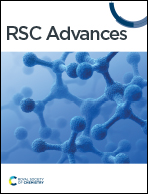Polyvinyl alcohol as solid proton donor to modify g-C3N4via hydrogen bonding enabling efficient photocatalytic H2O2 production from H2O and O2†
Abstract
Polyvinyl alcohol (PVA) was used as a solid proton donor to improve the photocatalytic performance of graphitic carbon nitride (CN) for hydrogen peroxide (H2O2) production. The modified CN (CN/PVA) was prepared by mixing CN and PVA at room temperature. The H2O2 production efficiency of CN/PVA was 5.65 times higher than that of CN in pure water. Photocurrent measurement, electrochemical impedance spectroscopy (EIS), and photoluminescence (PL) analysis proved that PVA increased charge separation of CN. X-ray photoelectron spectroscopy (XPS), and Fourier-transform infrared (FTIR) analyses further suggested that PVA acted as the proton donor during H2O2 production by interacting with CN via hydrogen bonds. The combination of the charge separation enhancer and proton donor from PVA promoted the sequential two-step single-electron reduction of O2 for H2O2 production. This study paves the way for the modification of g-C3N4 with hydroxyl-containing materials as solid proton donors for photocatalytic H2O2 production.



 Please wait while we load your content...
Please wait while we load your content...